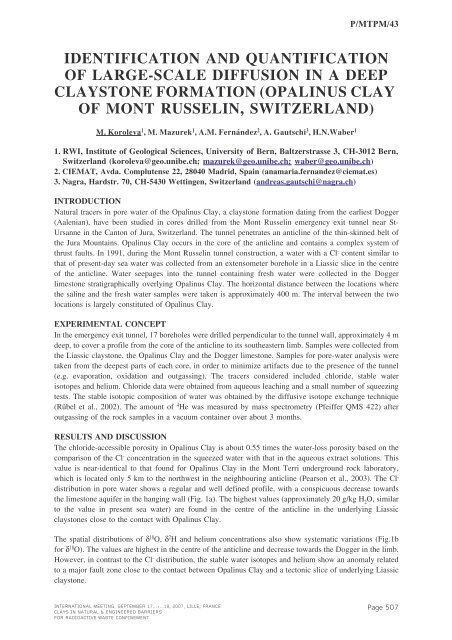Mass Transfer & Porous Media (MTPM) - Andra
Mass Transfer & Porous Media (MTPM) - Andra
Mass Transfer & Porous Media (MTPM) - Andra
Create successful ePaper yourself
Turn your PDF publications into a flip-book with our unique Google optimized e-Paper software.
P/<strong>MTPM</strong>/43IDENTIFICATION AND QUANTIFICATIONOF LARGE-SCALE DIFFUSION IN A DEEPCLAYSTONE FORMATION (OPALINUS CLAYOF MONT RUSSELIN, SWITZERLAND)M. Koroleva 1 , M. Mazurek 1 , A.M. Fernández 2 , A. Gautschi 3 , H.N.Waber 11. RWI, Institute of Geological Sciences, University of Bern, Baltzerstrasse 3, CH-3012 Bern,Switzerland (koroleva@geo.unibe.ch; mazurek@geo.unibe.ch; waber@geo.unibe.ch )2. CIEMAT, Avda. Complutense 22, 28040 Madrid, Spain (anamaria.fernandez@ciemat.es)3. Nagra, Hardstr. 70, CH-5430 Wettingen, Switzerland ( andreas.gautschi@nagra.ch )INTRODUCTIONNatural tracers in pore water of the Opalinus Clay, a claystone formation dating from the earliest Dogger(Aalenian), have been studied in cores drilled from the Mont Russelin emergency exit tunnel near St-Ursanne in the Canton of Jura, Switzerland. The tunnel penetrates an anticline of the thin-skinned belt ofthe Jura Mountains. Opalinus Clay occurs in the core of the anticline and contains a complex system ofthrust faults. In 1991, during the Mont Russelin tunnel construction, a water with a Cl - content similar tothat of present-day sea water was collected from an extensometer borehole in a Liassic slice in the centreof the anticline. Water seepages into the tunnel containing fresh water were collected in the Doggerlimestone stratigraphically overlying Opalinus Clay. The horizontal distance between the locations wherethe saline and the fresh water samples were taken is approximately 400 m. The interval between the twolocations is largely constituted of Opalinus Clay.EXPERIMENTAL CONCEPTIn the emergency exit tunnel, 17 boreholes were drilled perpendicular to the tunnel wall, approximately 4 mdeep, to cover a profile from the core of the anticline to its southeastern limb. Samples were collected fromthe Liassic claystone, the Opalinus Clay and the Dogger limestone. Samples for pore-water analysis weretaken from the deepest parts of each core, in order to minimize artifacts due to the presence of the tunnel(e.g. evaporation, oxidation and outgassing). The tracers considered included chloride, stable waterisotopes and helium. Chloride data were obtained from aqueous leaching and a small number of squeezingtests. The stable isotopic composition of water was obtained by the diffusive isotope exchange technique(Rübel et al., 2002). The amount of 4 He was measured by mass spectrometry (Pfeiffer QMS 422) afteroutgassing of the rock samples in a vacuum container over about 3 months.RESULTS AND DISCUSSIONThe chloride-accessible porosity in Opalinus Clay is about 0.55 times the water-loss porosity based on thecomparison of the Cl - concentration in the squeezed water with that in the aqueous extract solutions. Thisvalue is near-identical to that found for Opalinus Clay in the Mont Terri underground rock laboratory,which is located only 5 km to the northwest in the neighbouring anticline (Pearson et al., 2003). The Cl -distribution in pore water shows a regular and well defined profile, with a conspicuous decrease towardsthe limestone aquifer in the hanging wall (Fig. 1a). The highest values (approximately 20 g/kg H 2 O, similarto the value in present sea water) are found in the centre of the anticline in the underlying Liassicclaystones close to the contact with Opalinus Clay.The spatial distributions of δ 18 O, δ 2 H and helium concentrations also show systematic variations (Fig.1bfor δ 18 O). The values are highest in the centre of the anticline and decrease towards the Dogger in the limb.However, in contrast to the Cl - distribution, the stable water isotopes and helium show an anomaly relatedto a major fault zone close to the contact between Opalinus Clay and a tectonic slice of underlying Liassicclaystone.INTERNATIONAL MEETING, SEPTEMBER 17...>...18, 2007, LILLE, FRANCECLAYS IN NATURAL & ENGINEERED BARRIERSFOR RADIOACTIVE WASTE CONFINEMENTPage 507
















